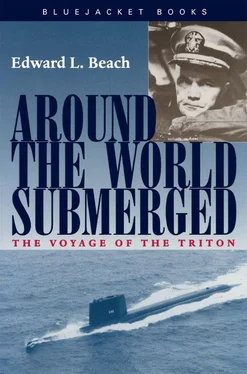Chief Engineman Hosie Washington, an ex-Navy steward who had changed his rate and was now our Chief Chemist, grinned happily at me. “She sure sounds nice, Captain!” he shouted, his eyes dancing in his handsome Negro face. I nodded my agreement as I passed him, and walked a few feet farther aft to the main control center of the engine room.
Lieutenant Commander Donald G. Fears, Les Kelly’s assistant during the building period, had taken over as Triton’ s Engineer Officer. Fears, a slightly built man with an intense face which belied his relaxed leadership, had the forward engine room watch, and I could see that he, too, was exhilarated by the performance of the machinery under his charge. He stood at a small watch-stander’s table before a low gaugeboard, displaying dials and switches. To one side, surveying two large consoles covered with a profusion of instruments, a Chief Petty Officer and a First Class Electronics Technician were perched on built-in stools, standing watch on the nerve center of the starboard reactor. Directly forward of Don, the starboard throttleman faced a similar console that recorded steam conditions.
This was “Maneuvering One,” the control station for the starboard engine. The efficient way in which the men moved about their tasks no doubt filled Don with pride, for their actions were a result of his training and indoctrination.
The purposeful noise of the great reduction gear beat upon our ears. It was not a shriek of protest, but the powerful frequency of a finely meshed set of gears doing their job without fuss, so solidly constructed and so perfectly matched that they transmitted a minimum of vibration into the water even though some of them were spinning thousands of revolutions per minute. Could they continue to run this way, without stopping, for almost three months? This was one of the answers our voyage was to determine.
Bidding Fears a silent farewell I continued my journey aft. Number two engine room contained identical equipment to number one, although arranged somewhat differently because it drove the other propeller, and I passed through it rapidly with only a brief greeting to Lieutenant George Troffer, in charge. Satisfied that the same atmosphere of calm confidence was evident here, I opened the watertight door into the after torpedo room.
Triton has torpedo tubes at each end, and as the name implies, this compartment contains Triton’ s stern set. In the after part, brightly lighted in contrast to the dimmed lights farther forward where forty-two men had their berths, I found Allen W. Steele, Torpedoman’s Mate Third Class, on watch. A sandy-haired, serious-faced sailor, twenty-one years old, he had made a good try for the Naval Academy Preparatory School a few months ago, but with insufficient time to prepare, his marks in the competitive examination were not high enough. He had done his best, as we had for him. Steele rose from the tool box upon which he had been sitting and gave me a cheerfully respectful salute.
Here, I had no trouble appreciating the power of our two huge bronze propellers, which clearly could be heard spinning in the water just a few feet away. As during our initial trials, the drumming of the steel fabric of Triton’ s great pressure hull could be felt through the soles of our feet or through our fingertips resting against the solid structure of a torpedo-loading skid.
I grinned. “How is it going, Steele?”
“Fine, sir!” he answered soberly, “but I’ll be glad when we dive and get rid of all this racket.”
Only a couple of years in submarines, he already had the submariner’s outlook. I found myself agreeing with him, as I made my way forward again.
On the bridge, the shrill wind sweeping over our exposed cockpit was cutting cold. I quickly became chilled through, despite the heavy coat, gloves, and old cap I had slipped on. Triton’ s course was still due south, and her throttles were open to allow full steam flow. It was now a little after five in the afternoon. The sun lay low in the southwest and dusk was gathering.
I turned to Lieutenant Hay. “What’s the latest sounding, Jim?” I asked him.
“We just got thirty-three fathoms a few minutes ago, Captain,” he said. “Do you want me to go ahead and dive at thirty-five fathoms?”
“Go ahead and get the bridge thoroughly secured, Jim,” I told him. “By the time you are ready, we’ll probably have reached the thirty-five-fathom line. I’ll let you know when to dive.”
As Hay busied himself with these last-minute preparations, I raised my glasses and scanned the sea to the horizon. There was a slight chop, with whitecaps coming from the south. Spray and spume closed Triton’ s foredeck, and occasionally the waves buried her sharp snout as our ship split them with her knife-blade stem. Our wake, a long, straight, broad furrow of white water, reached aft beyond the visible horizon. The lighthouse and radar towers of Montauk Point were long out of sight, and the coast of Long Island had receded from view.
The “21 MC” speaker on the bridge blared: “Bridge—Control! Sounding, three five fathoms!”
“That’s it, Jim,” I said. “When you are ready in all respects, take her down.” I deliberately spoke loudly for the benefit of the lookouts who, I knew, were eagerly hoping to get an inkling of where our mysterious trip was to take us. They were to get no satisfaction from me, yet. But there would be nothing wrong with teasing them a little. I swung myself on the ladder to go below.
“Be sure you get everything tightly secured,” I said. “We’re going to be a mighty long time down before we come up, and we don’t want any of this stuff shaking loose up here where we can’t get at it!” I chuckled inwardly. In a few minutes that bit of information would be all over the ship.
As I passed down through the conning tower into the control room, everyone sensed that this time my appearance heralded the time to dive. In the control room, Chief Radioman Joe Walsh, in charge of Triton’ s radio gang, was Chief of the Watch. When he saw me, he put down the cup of coffee he was holding. Slight, with blond hair and aquiline features, Walsh had been one of the first to check out on our Ballast Control Panel. It must have been Walsh who had been operating the fathometer. No one was near it at the present time. Tom Thamm stood unobtrusively in the background. To Walsh’s left stood Bob Carter, Machinist Mate First Class, Auxiliaryman of the Watch. In build and size similar to Walsh, though darker and with jet black hair, Carter might have posed for illustrations of the lanky sailor so often characterized as the ideal man-o-war’s man. Career Navymen and submariners for years, Walsh and Carter both had thoroughly checked out Triton ’s complicated equipment. We were in good hands.
Noting my attention, they self-consciously pretended unconcern. Inwardly, I smiled to myself. Diving was routine; Triton had already dived many times. But this was the start of our shakedown cruise, and they sensed that something out of the ordinary was planned. That this cruise was to be no ordinary cruise, this dive no ordinary dive, everyone on board must have realized.
I gripped the handrail of the ladder beneath the conning tower hatch through which I had just descended. Without even realizing they were doing it, Walsh and Carter ran their eyes over each of the individual controls before them, mentally checking them at the proper position and reviewing what they would do when the diving alarm sounded. For a moment or two nothing happened. Jim must be making a final check of the bridge, I thought. I hoped everything was tightly secured up there. Finally, I heard his voice through the bridge speaker system. “Clear the bridge. Clear the bridge!” Simultaneously, the diving alarm—an old-fashioned automobile horn—resounded through the ship.
Читать дальше












